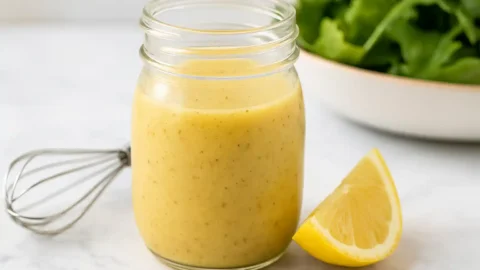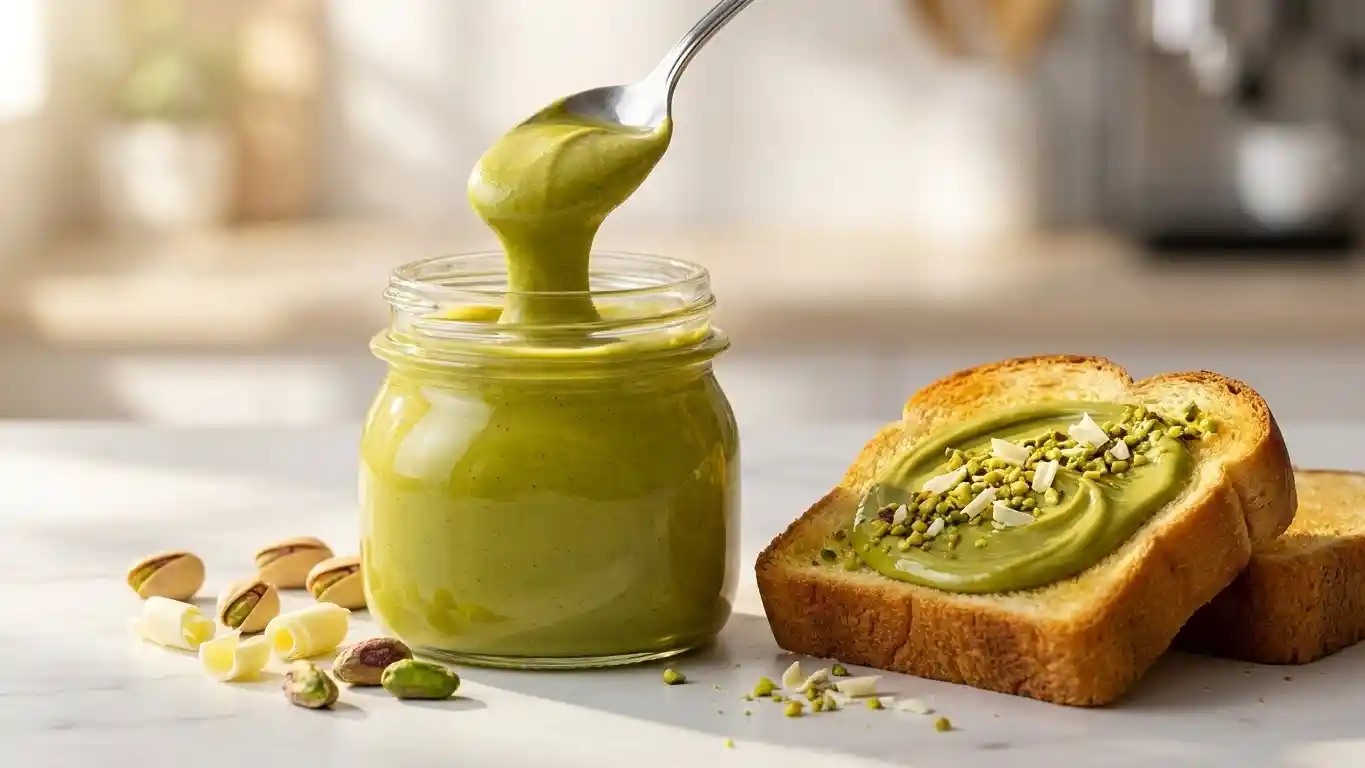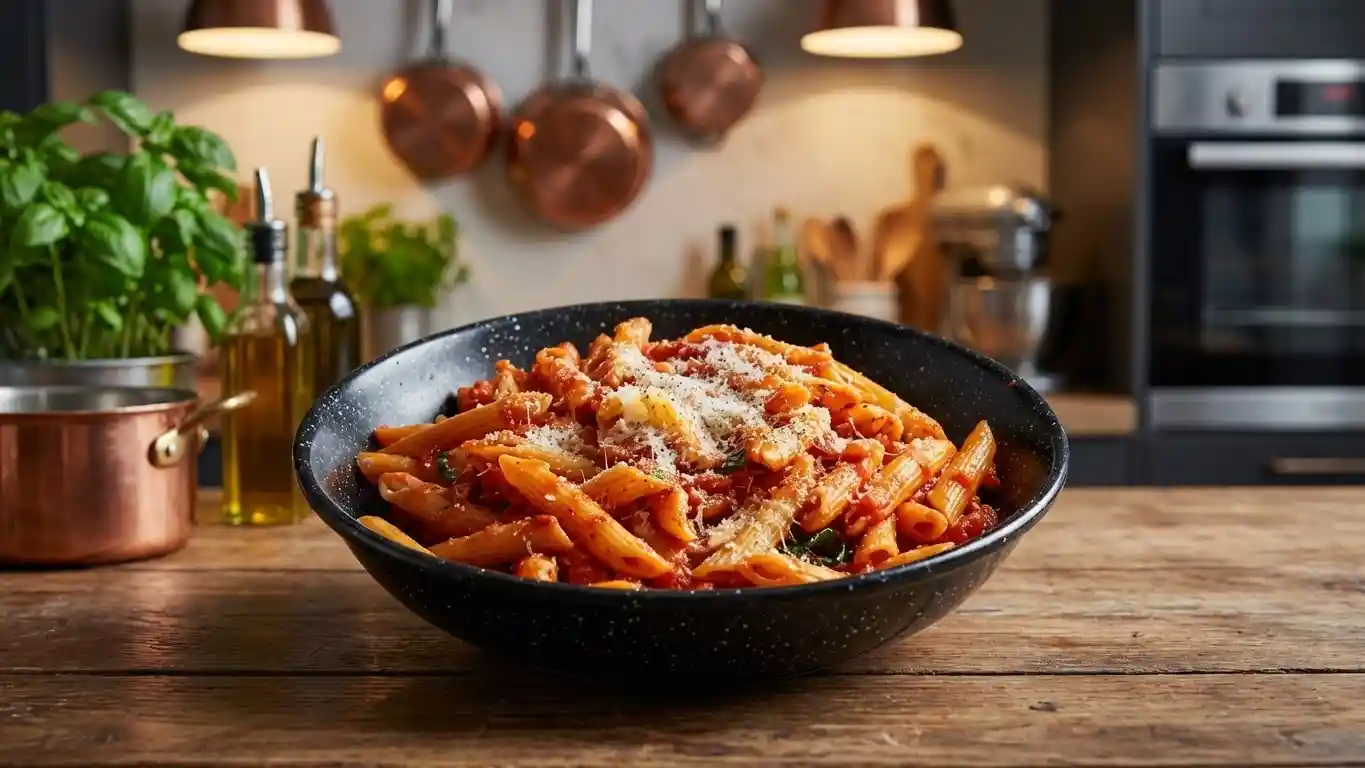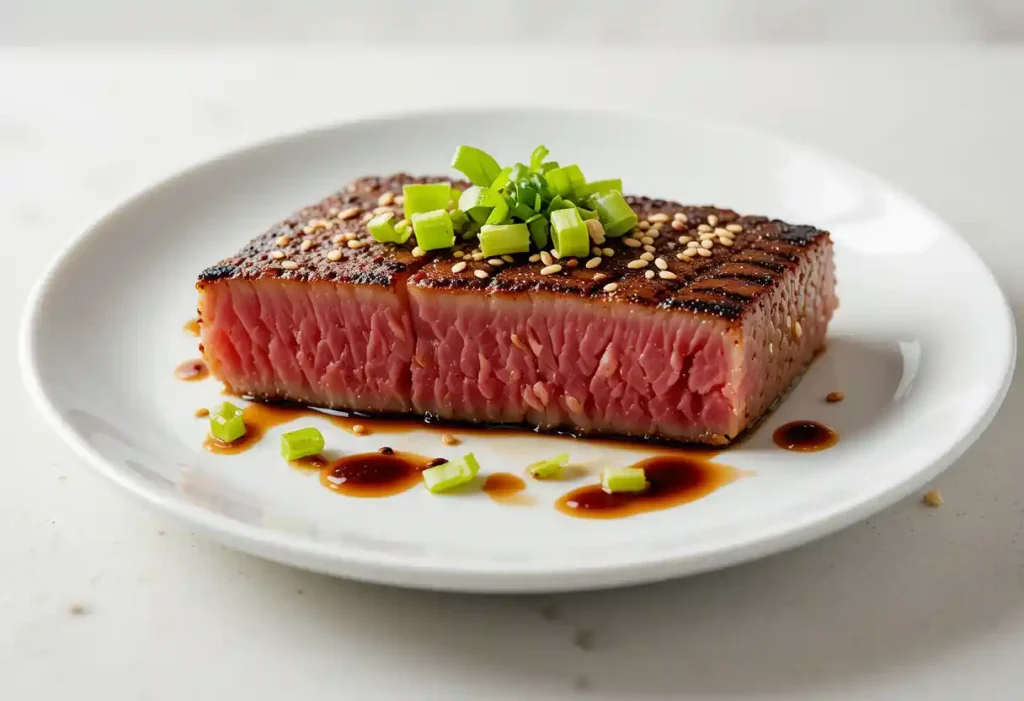Bright, zesty, and impossibly fresh, this Lemon Vinaigrette Recipe proves homemade dressing beats anything in a bottle. With a splash of real lemon juice and a few pantry staples, you can shake up liquid gold in minutes, turning simple greens into something crave-worthy. Skip the flat, preservative-laden supermarket options; this is the staple you’ll reach for all week. Grab a jar, squeeze a lemon, and unlock flavor that wakes up salads, veggies, grains, and more.
Table of Contents
Why You’ll Love Lemon Vinaigrette
- Ready in 5 minutes: whisk it together faster than finding a store-bought bottle
- Incredibly versatile: drizzle on salads, roasted veg, grain bowls, or use as a quick marinade
- Pure, simple ingredients: nothing but fresh lemon juice, good olive oil, and pantry staples
- Easily customizable: sweeten, creamify, or herb-infuse to match your taste
- Crowd pleaser: bright citrus flavor impresses family dinners, picnics, and potlucks alike
Ingredients Needed For Lemon Vinaigrette
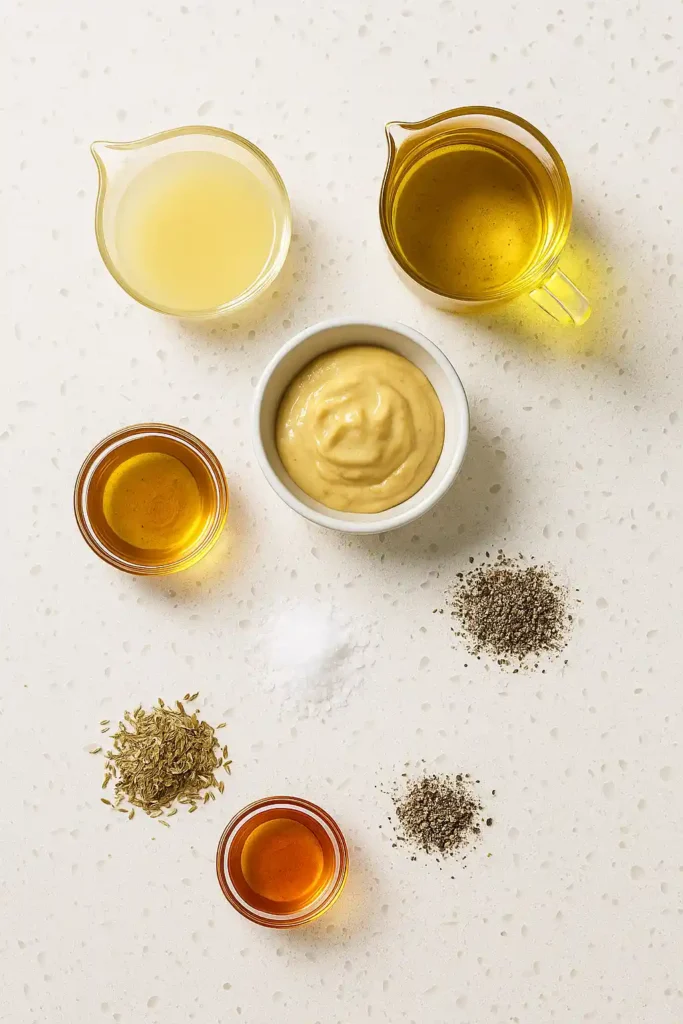
For the bright, tangy base
- ¼ cup fresh lemon juice, freshly squeezed for the boldest flavor
- 1 small garlic clove, finely grated for even flavor distribution
- 1 teaspoon Dijon mustard, the key emulsifier that keeps everything blended
Seasoning essentials
- ¼ teaspoon fine sea salt, plus more to taste
- A few twists of freshly ground black pepper for gentle heat
- ½ teaspoon honey or maple syrup, optional, to mellow sharp edges
Rich, silky finish
- ¼ to ⅓ cup extra-virgin olive oil, choose a fruity, good-quality brand
Optional flavor boosters
- ½ teaspoon fresh or dried thyme for an herby note
How To Make Lemon Vinaigrette
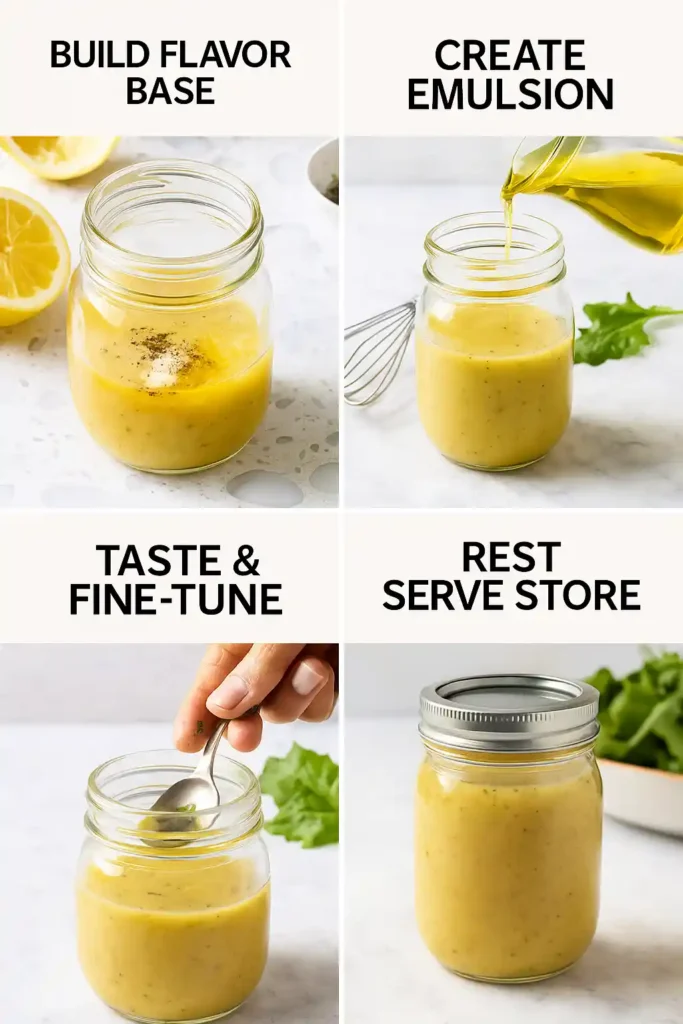
- Build the flavor base
In a small bowl or a jar with a tight lid, whisk the lemon juice with the grated garlic, Dijon mustard, sea salt, black pepper, and honey until the salt dissolves. This step lets the aromatics infuse the acid and sets up a balanced foundation. - Create the emulsion
While whisking briskly, drizzle the olive oil in a thin, steady stream. If using a jar, pour in the oil, secure the lid, and shake vigorously for about 30 seconds. Consistent motion breaks the oil into tiny droplets so the dressing turns silky and cohesive instead of separating. - Taste and fine-tune
Dip a lettuce leaf or spoonful to sample. If it tastes too sharp, whisk in another splash of olive oil or a pinch of honey to soften the acidity. Adjust salt and pepper to your liking. - Add optional thyme
Stir in fresh or dried thyme for an herbal lift, or leave it out for a classic version. - Rest, serve, and store
Let the vinaigrette sit for five minutes so flavors meld. Use right away, or pour into a clean jar, seal, and refrigerate for up to one week. Olive oil firms when cold, so let the jar stand at room temperature for five minutes, then shake or whisk until fluid before each use.
The Ultimate Customization Guide
- Creamy version: Whisk in one tablespoon of tahini or Greek yogurt until smooth.
- Cheesy or umami boost: Stir in one tablespoon nutritional yeast for a dairy-free option, or a heaped spoon of freshly grated Parmesan.
- Herbal twist: Fold in chopped thyme, rosemary, or chives for garden-fresh flavor.
- Milder bite: Swap the raw garlic for one tablespoon finely minced shallot, or omit garlic altogether.
- Sharper or softer acidity: Start with a classic three parts oil to two parts lemon juice. For a brighter snap use equal parts; for extra mellow notes add a splash more oil.
- Touch of heat: Pinch in red pepper flakes or a grind of Aleppo pepper.
- Sweeter finish: Drizzle an extra half teaspoon honey or maple syrup to round off the tang.
Variations
- Cheesy bake: Stir in one and a half cups of shredded cheddar or Gruyère during the final five minutes of baking so it melts into a bubbly topping.
- Spicy Cajun: Double the Creole seasoning, add a pinch of cayenne, and finish each serving with a splash of your favorite hot sauce.
- Italian herb: Swap the Creole blend for dried Italian seasoning, use sweet Italian chicken sausage, and sprinkle grated Parmesan on top at the end.
- Extra veggies: Fold in a cup of diced bell peppers, sliced mushrooms, or small broccoli florets along with the green beans for more color and nutrients.
Serving and Storage Tips
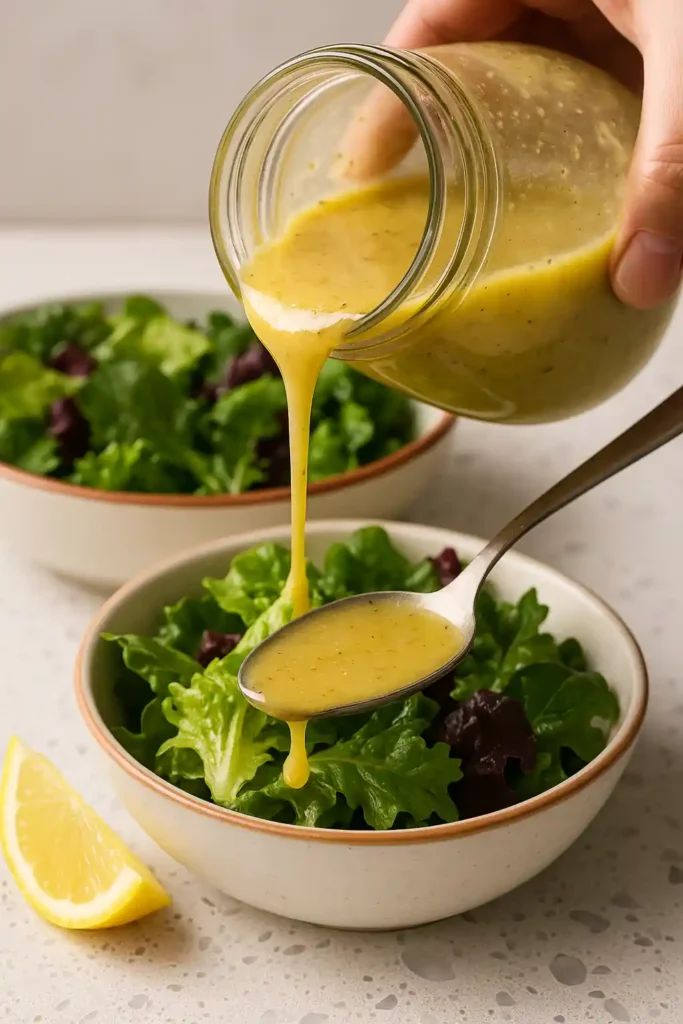
Make every dish pop
- Spoon over leafy salads, from simple arugula to hearty kale.
- Drizzle on hot roasted vegetables; the heat helps the citrus perfume the dish.
- Toss with cooked quinoa, farro, or couscous for an instant grain bowl.
- Use as a quick marinade for beans, chickpeas, or chicken before grilling.
- Pair with crusty bread as a bright dip or splash onto avocado toast.
Keep it fresh
Seal the vinaigrette in a clean glass jar and store in the refrigerator for up to one week. Olive oil firms when chilled, so place the closed jar in a bowl of lukewarm water or let it stand on the counter for five minutes, then shake or whisk until smooth.
Storage and Meal Prep
Store the vinaigrette in a glass jar with a tight lid and keep it in the refrigerator for up to seven days. The olive oil will turn cloudy and firm once chilled; set the jar on the counter for five to ten minutes or place it in a bowl of lukewarm water, then shake or whisk until it blends again.
For easy meal prep, make a double batch and portion it into small, single-use jars. Keep the extras cold and sealed, opening only what you need. If packing salads ahead, stash the dressing in a separate mini container and drizzle just before eating to keep greens crisp.
Conclusion
Bright citrus, silky texture, and pantry ease make this lemon vinaigrette your new standby. Just five minutes and a squeeze of fresh juice bring salads, veggies, and grain bowls to life. With its quick prep and flexible flavor options, it outshines any bottled dressing on the shelf. If you try it, please leave a star rating and a comment below so other readers can see how it went for you. Snap a pic and tag us on Pinterest or Facebook; we love seeing your creations. What twist did you add to make it your own? Share your ideas, and let’s inspire each other.
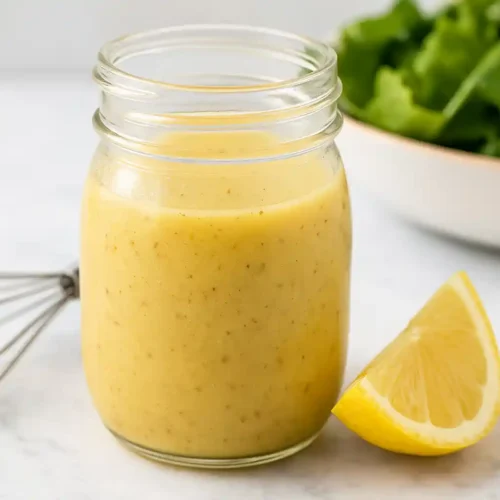
Lemon Vinaigrette Recipe
Ingredients
For the bright, tangy base
- ¼ cup fresh lemon juice freshly squeezed for the boldest flavor
- 1 small garlic clove finely grated for even flavor distribution
- 1 teaspoon Dijon mustard the key emulsifier that keeps everything blended
Seasoning essentials
- ¼ teaspoon fine sea salt plus more to taste
- A few twists of freshly ground black pepper for gentle heat
- ½ teaspoon honey or maple syrup optional, to mellow sharp edges
- Rich silky finish
- ¼ to ⅓ cup extra-virgin olive oil choose a fruity, good-quality brand
Optional flavor boosters
- ½ teaspoon fresh or dried thyme for an herby note
Instructions
Build the flavor base
- In a small bowl or a jar with a tight lid, whisk the lemon juice with the grated garlic, Dijon mustard, sea salt, black pepper, and honey until the salt dissolves. This step lets the aromatics infuse the acid and sets up a balanced foundation.
Create the emulsion
- While whisking briskly, drizzle the olive oil in a thin, steady stream. If using a jar, pour in the oil, secure the lid, and shake vigorously for about 30 seconds. Consistent motion breaks the oil into tiny droplets so the dressing turns silky and cohesive instead of separating.
Taste and fine-tune
- Dip a lettuce leaf or spoonful to sample. If it tastes too sharp, whisk in another splash of olive oil or a pinch of honey to soften the acidity. Adjust salt and pepper to your liking.
- Add optional thyme
- Stir in fresh or dried thyme for an herbal lift, or leave it out for a classic version.
Rest, serve, and store
- Let the vinaigrette sit for five minutes so flavors meld. Use right away, or pour into a clean jar, seal, and refrigerate for up to one week. Olive oil firms when cold, so let the jar stand at room temperature for five minutes, then shake or whisk until fluid before each use.
Notes
| Nutrition Facts (per serving) | |
|---|---|
| Calories | 128 kcal |
| Fat | 14 g |
| Saturated Fat | 2 g |
| Carbohydrates | 2 g |
| Sugars | 1 g |
| Protein | 0 g |
| Sodium | 135 mg |
| Fiber | 0 g |
Related Recipes to Lemon Vinaigrette
Mediterranean Lentil Salad with Feta : A wholesome salad that would pair beautifully with lemon vinaigrette.
Strawberry Cucumber Salad : Light, fruity, and refreshing — ideal with citrusy dressings.
Broccoli Salad : A crunchy and nutritious option, often dressed with vinaigrettes.
Southern Potato Salad : While typically creamy, it can be adapted to use lemon vinaigrette for a lighter version.
Creamy Avocado Tuna Salad : Avocado-rich but could be enhanced with a zesty lemon vinaigrette.
Healthy Chicken and Cheese Jalousie : A baked savory pastry that could benefit from a tangy side salad or lemon vinaigrette.
Frequently Asked Questions
What are the ingredients in lemon vinaigrette?
A classic lemon vinaigrette uses fresh lemon juice, extra-virgin olive oil, Dijon mustard, a small garlic clove, sea salt, black pepper, and (optionally) a touch of honey or maple syrup plus herbs like thyme.
How to create vinaigrette?
Whisk lemon juice, garlic, mustard, salt, pepper, and sweetener in a bowl until the salt dissolves. Slowly stream in olive oil while whisking so the dressing emulsifies and turns glossy. You can also put everything in a jar with a tight lid and shake hard for 30 seconds.
Does lemon vinaigrette go bad?
Yes. Because it contains fresh juice and raw garlic, keep it refrigerated in a sealed jar and use within seven days. Discard if it smells off, separates into thick clumps after warming, or shows cloudiness that will not blend.
What is the ratio of oil to vinegar or lemon juice?
Traditional French vinaigrettes use three parts oil to one part acid. For a brighter, citrus-forward flavor many cooks prefer two parts oil to one part lemon juice, or even equal parts for an extra tangy finish. Adjust to taste and to match the dish you are dressing.
Why is my lemon vinaigrette bitter?
Bitterness usually comes from an overly robust olive oil or pithy lemon peel getting into the juice. Use a mild, fruity olive oil, strain seeds and pulp, and balance sharp edges with a drizzle of honey or maple syrup. Whisk thoroughly; a broken emulsion can also taste harsher.

